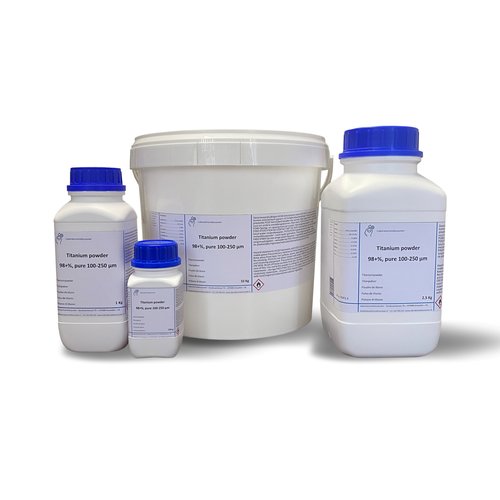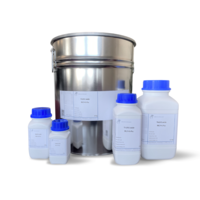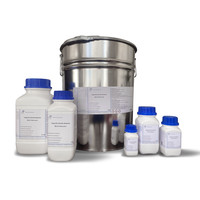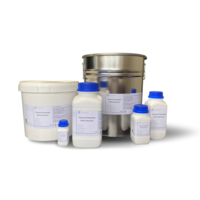You have no items in your shopping cart
Titanium 98 +%, powder 100-250 µm
- Buy 2 and save 5%
- Buy 6 and save 10%
Titanium is the chemical element with atomic number 22, symbol Ti.
Titanium belongs to group 4 of the periodic table (titanium group) with zirconium (Zr), hafnium (Hf) and rutherfordium (Rf), it is a transition metal. This element is found in many minerals, but the main sources are rutile and anatase.
Titanium is a light, strong metal with a metallic white appearance that is corrosion resistant. It is mainly used in light and strong alloys, and its oxide is used as a white pigment. The industrially interesting properties of titanium are its corrosion resistance, often associated with erosion and fire resistance, biocompatibility, but also the mechanical properties (strength, ductility, fatigue, etc.) that make it particularly possible to form thin and light parts. such as sports equipment, but also orthopedic prostheses.
Basic physical properties
Remarkable Physical Characteristics of Titanium:
the density is about 60% of that of steel;
its resistance to corrosion is exceptional in many environments, such as sea water or the human body;
its mechanical properties are preserved up to a temperature of about 600 ° C and remain excellent up to cryogenic temperatures;
it is available in a wide variety of shapes and types of products: blocks, billets, rods, wires, tubes, plates, plates, strips and powders;
the magnetic sensitivity value (1.8 to 2.3 x 10−4) is much lower than that of iron (3 x 105). It is therefore an advantageous material in diagnosis by means of MRI: reduction of artifacts;
the coefficient of expansion, slightly lower than that of steel, is half that of aluminum. The mean value is an expansion coefficient of 8.5 × 10−6 K - 1;
the Young's modulus or longitudinal modulus of elasticity is between 100,000 and 110,000 MPa. This relatively low value compared to stainless steel (220,000 MPa) makes it a particularly interesting material due to its biocompatibility.
Chemical properties
-Classic titanium corrosion
Titanium is an extremely oxidizable metal. In the series of standard electrochemical potentials, it is placed near aluminum, between magnesium and zinc. It is therefore not a noble metal, its thermodynamic stability domain in fact has no part in common with the thermodynamic stability domain of water and is located significantly below it. One of the causes of titanium's corrosion resistance is the development of a few micron fractions of a micron passivating protective layer, usually composed of TiO2, but it is known to contain other variants. This layer is integral and very tight. If the surface is scratched, the oxide will spontaneously reform in the presence of air or water. Titanium is therefore unchangeable in air, water and seawater and, moreover, this layer is stable over a wide range of pH, potential and temperature.
Very reducing conditions, or strongly oxidizing environments, or the presence of fluorine ions (complexing agent), reduce the protective character of this oxide layer; etching reagents for recording micrographs are usually based on hydrofluoric acid. Upon reaction with this acid, titanium (II) and (III) cations are formed. However, the reactivity of acidic solutions can be reduced by the addition of oxidizing agents and / or heavy metal ions. Chromium or nitric acid and salts of iron, nickel, copper or chromium are then excellent inhibitors. This explains why titanium can be used in industrial processes and environments where conventional materials would corrode.
Of course, the electrochemical equilibria can be altered by adding elements that reduce the anodic activity of titanium; this leads to an improved corrosion resistance. Depending on the wishes of changes, specific elements are added. A non-exhaustive list of some classical adjuvants is provided below:
displacement of the corrosion potential and enhancement of the cathode character: addition of platinum, palladium or rhodium;
increased thermodynamic stability and reduced tendency to anodic dissolution: addition of nickel, molybdenum or tungsten;
increased tendency to passivation: addition of zirconium, tantalum, chromium or molybdenum.
Specific corrosion of titanium
Titanium is not very sensitive to certain types of corrosion, such as crevice corrosion or pitting corrosion. These phenomena are only observed when used in an area close to a practical limit for general corrosion resistance. The risks of stress corrosion cracking occur under the following conditions:
cold in sea water;
in certain specific media such as anhydrous methanol;
hot, in the presence of molten NaCl.
The two allotropic structures differ in terms of resistance to the latter type of corrosion; α-titanium is very sensitive to it, while β is almost not.
-Mechanical properties
Erosion
The highly adhesive and hard oxide layer explains the long life of titanium parts exposed to the impact of particles floating in the liquids. This effect is enhanced by the ability of this layer to regenerate. Erosion in seawater is increased by a higher current or smaller particle size.
Strength and formability
Titanium is considered a metal with high mechanical strength and good formability under normal temperature conditions. The specific strength (tensile strength / density ratio) is, for example, higher than that of aluminum or steel. Resistance decreases at temperature with a ridge between -25 ° C and 400 ° C. Below -50 ° C, in cryogenic temperature ranges, strength increases and ductility decreases sharply.
Biocompatibility
Titanium is one of the most biocompatible metals, along with gold and platinum, that is, it is completely resistant to body fluids.
In addition, it has high mechanical strength and very low modulus of elasticity (100,000 MPa to 110,000 MPa), closer to that of bone structures (20,000 MPa) than stainless steel (220,000 MPa). This elasticity, which promotes bone remodeling by forcing bone to function (prevention of stress shielding or peri-implant osteoporosis), makes titanium a particularly interesting biomaterial. However, it should be noted that excessive elasticity can also compromise the function of the biomaterial, which would have undergone unacceptable deformation.
Fire resistant
Resistance to fire, especially hydrocarbons, is very good. A pipe with a thickness of 2 mm has been shown to withstand a pressure of ten atmospheres without damage or risk of deformation or explosion while being exposed to a hydrocarbon fire at a temperature of 600 ° C. This is mainly due to the strength of the oxide layer that prevents the penetration of hydrogen into the material. In addition, the low thermal conductivity of titanium protects the internal components against temperature rise for a longer period of time.
Technical data:
Empirical formula Ti
Molar mass (M) 47,867 g / mol
Density (D) 4.506
Boiling point (bp) 3287 ° C
Melting point (mp) 1668 ° C
ADR 4.1 II
CAS No. [7440-32-6]
UN No. 3089
$$$$$
Product information
Technical specifications
Hazard statements
H228 Flammable solid
H261 In contact with water releases flammable gases
Precautions - prevention
P210 Keep away from heat, hot surfaces, sparks, open flames and other ignition sources. Do not smoke.
Precautions - response
P370 + P378 In case of fire: Use metal extinguishing powder to extinguish - never use water.
Precautions - storage
P402 + P404 Store in a dry place. Keep in a closed container.









